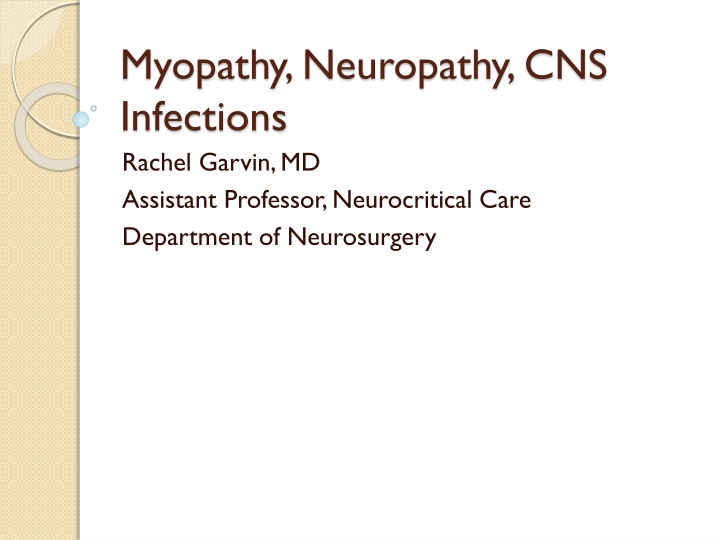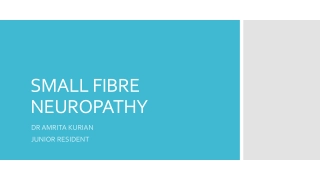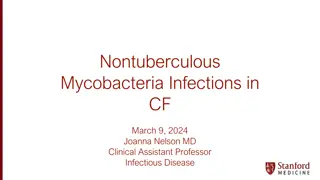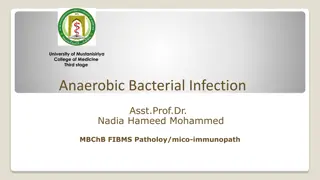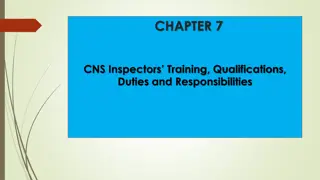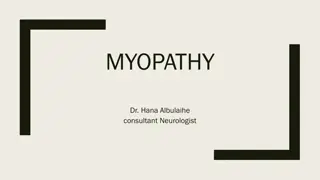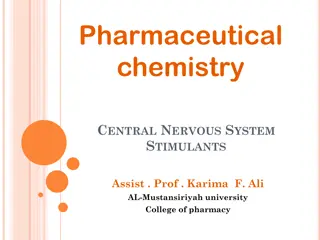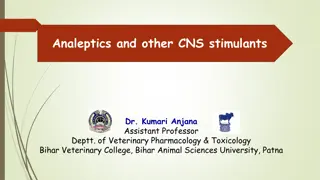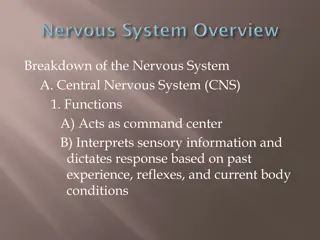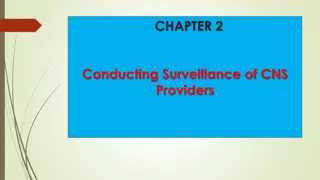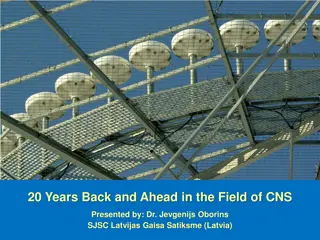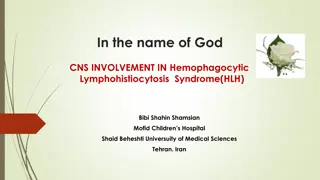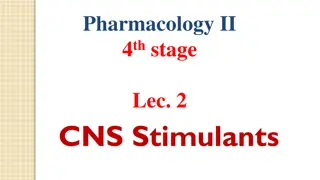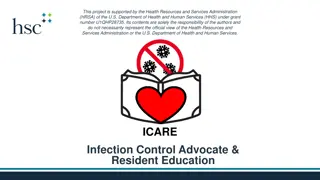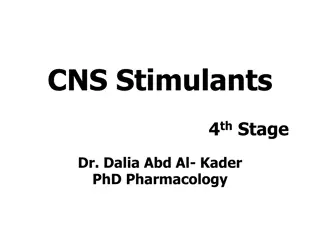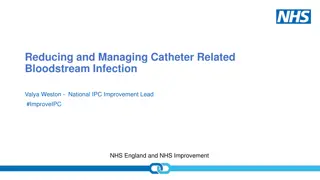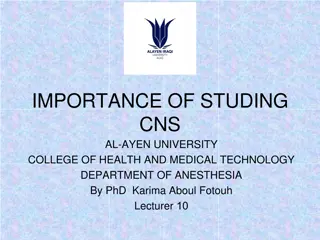Myopathy, Neuropathy, CNS Infections
In this presentation, Dr. Rachel Garvin covers critical care myopathy and neuropathy causes, diagnosis, and management, as well as CNS infections, their diagnosis, and management. Learn about CIM/CIP, CIP diagnosis, CIM diagnosis, and recovery/management approaches. Explore CNS infections, including meningitis, ventriculitis, encephalitis, and brain abscesses. Understand the differences between bacterial and other infectious meningitis, its common causes, and classic signs.
Download Presentation

Please find below an Image/Link to download the presentation.
The content on the website is provided AS IS for your information and personal use only. It may not be sold, licensed, or shared on other websites without obtaining consent from the author.If you encounter any issues during the download, it is possible that the publisher has removed the file from their server.
You are allowed to download the files provided on this website for personal or commercial use, subject to the condition that they are used lawfully. All files are the property of their respective owners.
The content on the website is provided AS IS for your information and personal use only. It may not be sold, licensed, or shared on other websites without obtaining consent from the author.
E N D
Presentation Transcript
Myopathy, Neuropathy, CNS Infections Rachel Garvin, MD Assistant Professor, Neurocritical Care Department of Neurosurgery
Objectives Describe critical care myopathy and neuropathy, causes, diagnosis and management Describe CNS infections, diagnosis and management
Critical Illness Polyneuropathy (CIP) and Myopathy (CIM) Seen in conjunction with severe sepsis and prolonged use of neuromuscular blockade +/- steroids Seen in up to 40% of ICU patients
CIM/CIP First sign is often inability to wean from ventilator Not usually noted until patient at least 2 weeks on ventilator Severe diffuse weakness and muscle wasting
CIP Diagnosis by EMG Axonal degeneration of motor and sensory fibers CK is normal Muscle biopsy shows denervation atrohpy
CIM EMG shows myopathic muscle units Elevated serum CK Biopsy shows myopathy with loss of myosin
Recovery/Management No specific treatment supportive care Range of levels of recovery
CNS Infections Meningitis/Ventriculitis Encephalitis Brain Abscess
Meningitis Bacterial (septic) vs Other infectious or inflammatory (aseptic) Most often caused by bacteremia that seeds meninges by crossing BBB and multiplying in CSF Ventriculitis more common in those with ventricular drains/shunts Cerebral edema can occur d/t inflammatory effects of infection leading to vasogenic and cytotoxic edema
Meningitis Classic signs of fever, HA and meningismus may not always be present (esp. elderly) Also seen with photophobia, N/V, altered consciousness Pathogens dependent on: Adult in community: strep pneumo, neisseria, listeria Hospitalized patient: gram negatives
Meningitis Dx: LP Elevated opening pressure (>20cmH2O) Increased protein (>100mg/dl) Decreased glucose (<40% serum level) Elevated nucleated cell count (usually >100)
Complications SIADH (50% of cases) Seizures Elevated ICP risk of herniation
Treatment Abx appropriate to pathogen Ensure appropriate CNS dosing Duration from 14-21 days depending on pathogen
Encephalitis Infection of brain parenchyma Multiple modes of infection Most are hematogenous spread except for HSV and rabies which spread via neurons Most are viral
Encephalitis: Presentation Varies as certain infections have certain locations they affect: HSV: inf/medial temporal lobes and orbito-frontal cortex Arboviruses (West Nile, equine): cortical gray matter, brainstem and thalamic nuclei Japanese B virus: brainstem nuclei and basal ganglia
Encephalitis: Diagnosis History and physical Neuroimaging: CT and MRI LP: many present as meningoencephalitis HSV PCR may be falsely negative in first 48 hours and then again 10 days after infection Other viruses: IgM in CSF, viral culture from blood, tissue or CSF
Encephalitis: Treatment and Outcomes Only treatment for HSV with Acyclovir for 14 days Other viruses are supportive care only
Brain Abscess Encapsulated collection of pus within brain parenchyma Risk factors include: head and neck infections, penetrating head injury, immunocompromised state Presentation often non-specific but can have symptoms related to location of abscess
Brain Abscess: Pathophysiology Begins as a cerebritis, day 1-3 with surrounding inflammation and edema 1 week into infection, central necrosis develops By 14 days, fibrous capsule apparent which becomes more established
Brain Abscess: Diagnosis History and Physical CT + contrast MRI Needle-guided aspiration
Braun Abscess: Complications Seizures are most common morbidity (up to 70%) Abscess rupture leading to meningitis/ventriculitis Formation of subdural empyema, epidural abscess, septic thrombophlebitis
Brain Abscess: Treatment IV abx based on pathogen or presumed source (otitis, odontogenic) Surgical drainage
CNS Fungal Infections Seen mostly in immunocompromised patients Can present in any form (meningitis abscess) Often difficult to grow in culture Treatment with ampho B
